How to Measure Developer Productivity To Better Efficiency
In the dynamic world of software development, measuring productivity isn’t as straightforward as counting lines of code or hours spent on the keyboard.
Developer productivity is a multifaceted concept that involves various factors, both qualitative and quantitative. It’s not just about coding faster; it’s about achieving efficient, high-quality results while adopting collaborative and satisfying work behaviors.
In this article, we will teach you how to measure developer productivity, its challenges, why it matters, and the strategies, metrics, and tools you can employ to do so effectively. So, if you want to learn more about it, keep scrolling!
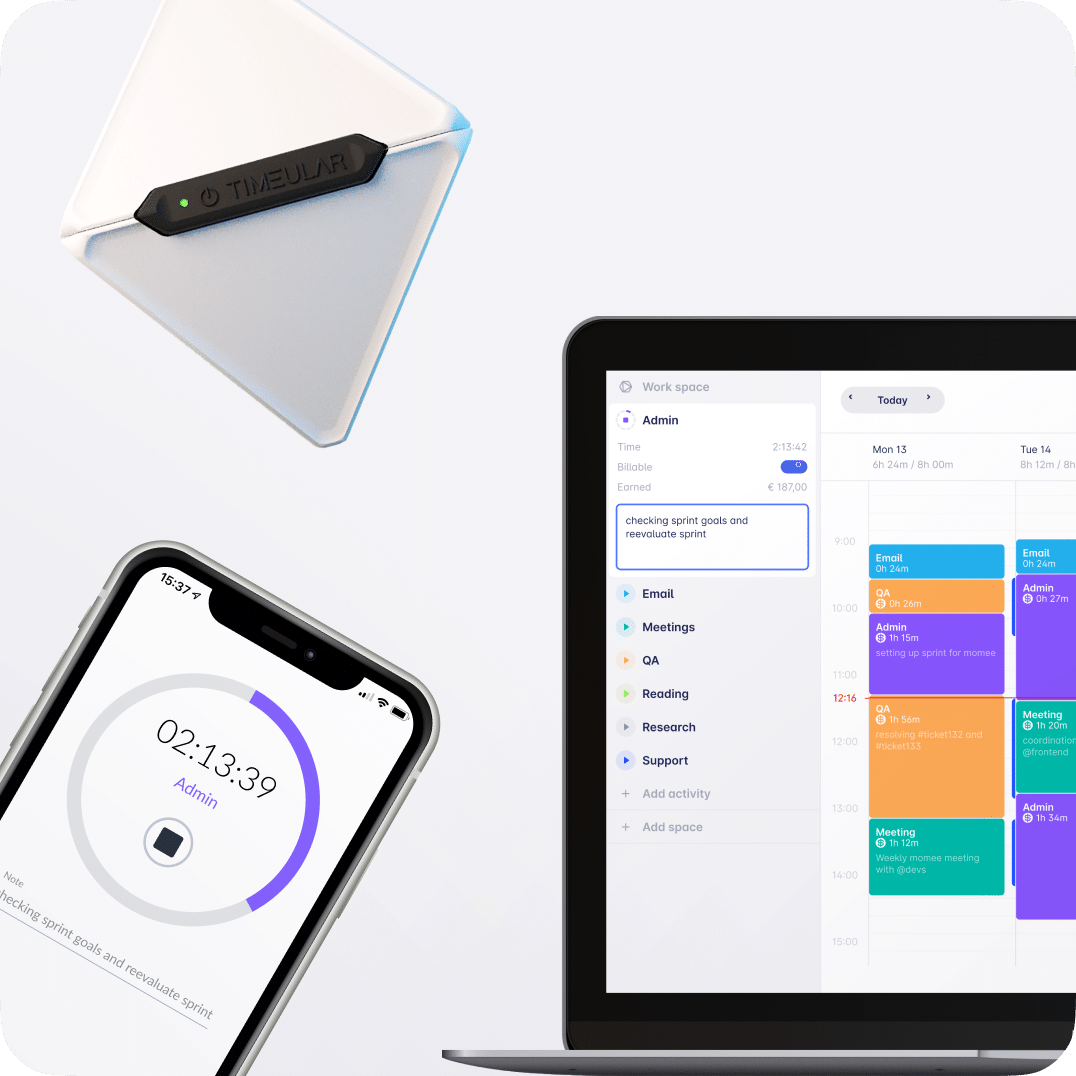
Discover how time tracking can offers accurate insights into your development team performance.
What is developer productivity?
Developer productivity refers to a developer’s ability to efficiently produce valuable and high-quality code. It involves various skills and practices, including coding, problem-solving, teamwork, communication, and adaptability.
High developer productivity isn’t just about writing more lines of code; it’s about achieving more with less, minimizing errors, and consistently delivering software that meets user needs.
Why is developer productivity important?
Let’s explore some of the key reasons why developer productivity is super important:
- Faster time-to-market: speed is often the difference between success and failure in the tech industry. Productivity improvements can significantly reduce the time it takes to develop and release new features or products, giving your company a competitive edge.
- Cost-efficiency: efficient developers save time and resources, reducing project costs and increasing the profitability of a business. High productivity ensures that your software development projects stay on budget.
- Quality assurance: productivity isn’t just about speed; it’s also about maintaining high-quality standards. Highly productive developers are likelier to write clean, maintainable code and conduct thorough testing, resulting in fewer bugs and better software.
- Developer satisfaction and well-being: high developer productivity isn’t solely about output; it’s also about creating a work environment that fosters job satisfaction and well-being. Happy developers are more likely to stay with your organization and perform at their best.
- Competitive advantage: companies that prioritize and measure developer productivity gain a competitive advantage. They attract top talent, develop innovative solutions faster, and respond more effectively to market changes.
Read also: Project profitability analysis

Measuring developer productivity: top tips and strategies
Measuring developer productivity isn’t a one-size-fits-all endeavor. It hinges on several factors, including workflow, deployment methodologies, team dynamics, the development environment, and the software delivery process.
Tailoring the right strategy and metrics for your team and individual developers can help them focus on essential tasks.
In essence, productivity assessment often refers to tracking work completion and the quality or significance of the achieved results.
Here are some top tips on measuring developer productivity, emphasizing the importance of both process and outcomes:
Assessing every individual developer on the same level may not generate accurate insights. Developers have distinct roles within a team, and their contributions differ accordingly.
While it may be tempting to measure individual performance, consider these team-centric metrics:
- Number of code reviews
- Frequency of code reviews
- Number of commits
- Average commit size
- Time taken for code review
However, focusing on measuring teams collectively is advisable rather than singling out individuals.
- Sjekk ut: De beste produktivitetspodcastene

Identify the right productivity and project management tools
Measuring productivity effectively relies on selecting criteria that align with your organization’s goals and needs.
To determine the most precise productivity measurements, you must evaluate which metrics best suit your requirements. Here are some tools to consider:
- Timeular: effortless time-tracking, billable tracking, and leave management solution
- Asana: work management
- Linear: bug tracking and work management
- Monday.com: team productivity
- Empuls: employee engagement
- Bonusly: employee recognition and rewards
- Wrike: all-in-one collaboration (Read: Wrike time tracking integration)
- Slack: communication
(Read also: Slack time tracking) - Zoom: meetings
By knowing the impact you want to make, you’ll be better equipped to choose the right tools for assessing performance.
See also: The best project management tools

Utilize the SPACE Framework
Relying solely on output-based metrics, such as the number of commits, may overlook essential aspects of productivity.
Developers might be working long hours, but the productivity assessment may be incomplete if the outputs lack quality or fail to deliver customer value.
What is the SPACE framework
To comprehensively gauge developer productivity, consider the SPACE framework, developed by research and strategy expert Nicole Forsgren in collaboration with Microsoft and GitHub.
This framework offers a holistic perspective on measuring developer productivity and equips managers with the tools to accurately assess productivity changes.
The SPACE framework presents a systematic approach to measuring, comprehending, and optimizing engineering productivity.
This framework emphasizes the importance of metrics, their interconnection, and their alignment with team objectives.
The framework segments engineering productivity into five distinct dimensions:
- Satisfaction and well-being
- Performance
- Activity
- Communication and collaboration
- Efficiency and flow
1. Prioritize developer satisfaction and well-being
This dimension revolves around employee satisfaction and well-being, often measured through employee surveys. It seeks to understand if team members are content, happy, and maintaining healthy work habits.
Satisfaction and well-being are closely tied to productivity, serving as possible leading indicators. Teams that are highly productive but unhappy may be heading towards burnout. While quantifying satisfaction and well-being directly can be challenging, objective metrics can highlight circumstances that might lead to dissatisfaction or burnout.
Combining quantitative metrics with qualitative insights and survey data helps leaders better evaluate team satisfaction.
For instance, in Code Climate Velocity, metrics like Coding Balance provide insights into developer workload. Coding Balance reveals the percentage of contributors responsible for the most impactful work.
An uneven distribution of work can result in overwhelmed team members or a lack of challenge for those handling less impactful tasks. Another useful metric is Work in Progress PRs, indicating the number of Pull Requests with activity over 72 hours. High numbers here could signal frequent context-switching, hindering developers from achieving a state of flow.
Typically, 1-2 PRs per developer is considered ideal. Monitoring short-term changes and overall trends in satisfaction helps leaders identify potential issues and advocate for necessary changes, such as additional time off to prevent exhaustion.
Read also: Ways to motivate employees and increase productivity

2. Performance
The SPACE Framework advises assessing performance based on the outcomes of a developer’s work. This can be reflected in code quality or the impact of their work on the product’s success.
Key metrics for evaluating performance include Defect Rate and Change Failure Rate. Change Failure Rate is crucial as it measures the percentage of deployments causing failures in production. This metric provides insights into code quality and its effect on customers. Every production failure consumes time that could have been spent on new features, adversely impacting customers.
When evaluating team performance, PR Throughput becomes important. This metric counts the number of PRs merged over time, representing bug fixes, new features, or improvements. PR Throughput is correlated with output and progress. To gain a comprehensive view of performance, it’s essential to consider PR Throughput alongside quality metrics to ensure that the team delivers at a high volume while maintaining code quality.
3. Activity
Activity refers to developer outputs, including on-call participation, opened pull requests, code reviews, or written documents. While this dimension appears similar to traditional productivity measurements, the SPACE Framework emphasizes that activity should not be viewed in isolation. It must always be considered in the context of qualitative information and other metrics.
Useful activity metrics within Velocity include Commits Per Day (the average number of times active contributors commit code per coding day) and Pushes Per Day (the average number of times active contributors push per day).
These metrics offer an overview of developer activity, helping assess workload balance, alignment with expectations, and alignment with strategic goals.
Additionally, Deployment Frequency measures how often teams deliver new features or bug fixes to production, providing insights into the team’s ability to deliver quickly.

4. Communication and collaboration
Highly effective teams prioritize transparency and communication. This ensures that developers understand priorities, see how their work contributes to broader initiatives, and learn from their peers.
Metrics for measuring communication and collaboration include review coverage and documentation quality.
Velocity supports Pair Programming, promoting collaboration, with credit attributed to two developers who code together. Review Speed, Time to First Review, and Review Coverage are useful metrics for assessing collaborative code review processes, ensuring that collaboration remains a focal point and that there’s ample time for reviewing PRs and providing thoughtful feedback.
Read also: How to improve communication in a team
5. Efficiency and flow
Efficiency and flow are key to minimizing developer frustration. Efficiency refers to individual speed, while flow relates to team-level efficiency. Both are essential for a seamless development process.
It’s important to strike a balance, as excessive efficiency and flow can sometimes come at the expense of collaboration and review. Perceived efficiency and flow can be gauged through surveys, while objective speed metrics provide a more quantifiable measurement.
For example, Velocity and Cycle Time represent a team’s time to market. Lower Cycle Time often signifies a higher output of features and bug fixes reaching customers quickly. This metric objectively evaluates how process changes affect a team’s productivity.
Mean Lead Time for Changes measures how swiftly code changes reach production, reflecting the team’s ability to react quickly. These metrics indicate whether the team’s culture and processes effectively handle a high volume of requests.
Read also: Difference between productivity and efficiency
Final note:
The SPACE Framework encourages engineering leaders to adopt a comprehensive perspective when considering developer productivity.
These five dimensions serve as vital reminders that developer productivity isn’t solely reliant on individual team members’ efforts but on the team’s collaborative synergy as they work towards a shared goal.

Developer productivity metrics
To measure developer productivity effectively, you need a combination of quantitative and qualitative metrics. Let’s explore some examples:
Quantitative metrics
- Lines of Code (LoC) written: this metric measures the amount of code produced by a developer. However, it should be used cautiously, as more code doesn’t necessarily mean higher productivity.
- Lead time: lead time tracks the time it takes from the start of a development task to its completion. Shorter lead times indicate higher productivity.
- Bug fix rate: this metric quantifies how quickly developers address and resolve reported bugs. A low bug fix rate could indicate a lack of productivity.
- Velocity: commonly used in Agile development, velocity measures the amount of work a development team completes in each iteration. It provides insights into team productivity.
- Code churn: code churn calculates the percentage of code that changes frequently. High code churn may indicate a lack of code stability or ongoing issues.
Read also: Time tracking in Jira
Qualitative metrics
- Code quality: evaluate the quality of code through code reviews, static analysis, and testing. High-quality code is more maintainable and less prone to defects.
- User satisfaction: survey end-users or stakeholders to gather feedback on the software’s functionality and usability.
- Peer reviews: assess the effectiveness of code reviews by evaluating the thoroughness and constructive feedback provided by team members.
- Job satisfaction surveys: regularly survey developers to gauge their job satisfaction, well-being, and overall morale.

Slik måler du utviklernes produktivitet
Now that we’ve covered the dimensions and types of metrics let’s explore how to measure developer productivity effectively:
- Define clear objectives: before measuring productivity, define clear objectives and key performance indicators (KPIs). Determine what success looks like for your development team and organization.
- Implement time tracking: while not the only measure of productivity, tracking time can provide valuable insights. Use time-tracking tools to monitor how developers allocate their time to different tasks and projects. This will help you and them to make informed decisions about time and resource allocation.
- Use version control data: version control systems like Git provide data on code changes, commit frequency, and code review activities. Analyze this data to gain insights into developer behavior.
- Adopt project management tools: tools like Jira, Trello, or Asana can help track project progress, tasks, and issue resolution times.
- Monitor code review metrics: monitor code review metrics, such as the time taken to review code, the number of comments, and the speed of code integration.
- Conduct regular surveys: use surveys to collect qualitative data on developer satisfaction, collaboration, and well-being. Act on the feedback to improve working conditions.
Read also: Track time in Asana
Current ways people are measuring developer productivity
Measuring developer productivity can take various approaches, depending on the organization’s goals and values. Here are some common ways organizations approach this task:
Check individual productivity
Some organizations focus on individual developer productivity, using metrics like lines of code written, bug fix rates, and code churn.
Individual productivity metrics can be useful for identifying top performers and areas where developers may need improvement.
Measure productivity at the team level
Others prefer to measure productivity at the team level, emphasizing collaboration and collective outcomes. These organizations deliberately avoid measuring individuals, believing it can lead to unhealthy competition and stress.
Metrics like team velocity, lead time, and code quality are commonly used to assess team productivity.
Measure both individuals and teams
Many organizations strike a balance by measuring both individual and team productivity.
They recognize that individual contributions and team dynamics are both essential for success.

8 tips to improve developer productivity
Here are seven tips that can help your development team reach new heights of productivity, ensuring that you stay ahead:
1. Choose the right tools
have a look at this list of best developer productivity tools. These tools automate repetitive tasks, enhance code writing and debugging, and facilitate efficient team collaboration.
For example, version control systems ensure seamless team coordination, while testing frameworks and debugging utilities help identify and rectify errors swiftly.
Documentation generators and code analysis tools further aid in maintaining code quality. With these resources at their disposal, developers can allocate more time to critical thinking and innovation, ultimately creating higher-quality products.
Read also: GitLab time tracking integration
2. Foster information sharing
Establish open channels of communication to streamline workflow and accelerate tasks.
Methods like Kanban boards, Scrum boards, daily stand-up meetings, Slack channels, and team lunches promote information sharing and inclusivity.
With structured communication, developers can document and share complex processes, ensuring vital information remains accessible even after team members change roles.
3. Match skills to projects
Inadequate delegation is a common cause of team overload. So, recognize that each developer possesses unique strengths and expertise. Productivity soars when developers work on tasks that align with their skills.
Encourage developers to fill out skill profiles, enabling you to assemble well-rounded teams for specific projects.
Read also: What is a tiger team in business?
4. Automate repetitive tasks
Don’t burden developers with repetitive, menial tasks when workplace automation can handle them efficiently. Simplify complex problems by breaking them down into automated processes.
Leveraging specialized developer solutions, such as Middleware and others, can streamline data management, application services, messaging, authentication, and API management.
TIP: Have a look at this list of the best task automation tools.
5. Establish realistic goals
Goals serve as motivational tools for structuring plans and achieving project milestones. However, setting overly tight and unrealistic goals and deadlines can overwhelm the team.
Engage developers in the deadline-setting process, allowing them to estimate software development time while accounting for potential challenges or priorities. The S.M.A.R.T. framework is a valuable resource for setting realistic goals.
6. Master your IDE
Competence in using an integrated development environment (IDE) is essential. Ensure that developers receive proper training in IDE usage to maximize work efficiency.
Plugins and code snippets can complement the IDE, automating repetitive tasks and streamlining processes. Syntax highlighting and code editors equipped with features like indentation, refactoring, and autocomplete further enhance productivity.
7. Avoid multitasking
Reducing multitasking is one of the best ways to improve employee productivity. Task-switching can lead to distractions, constant backtracking, and wasted time.
Encourage developers to focus on one task at a time, especially when dealing with intricate coding projects. A concentrated approach minimizes errors and maximizes productivity.
Read also: How to improve focus and concentration
8. Prioritize work-life balance
Encourage employees to prioritize their well-being over excessive work hours. Working longer doesn’t necessarily mean working better, and sleep deprivation can decrease developer productivity by a significant 50%.
Emphasize the importance of maintaining a healthy work-life balance, especially in remote work settings. Encourage routines that allow time for relaxation and rejuvenation. Regular exercise and a balanced diet also play a role in boosting productivity.
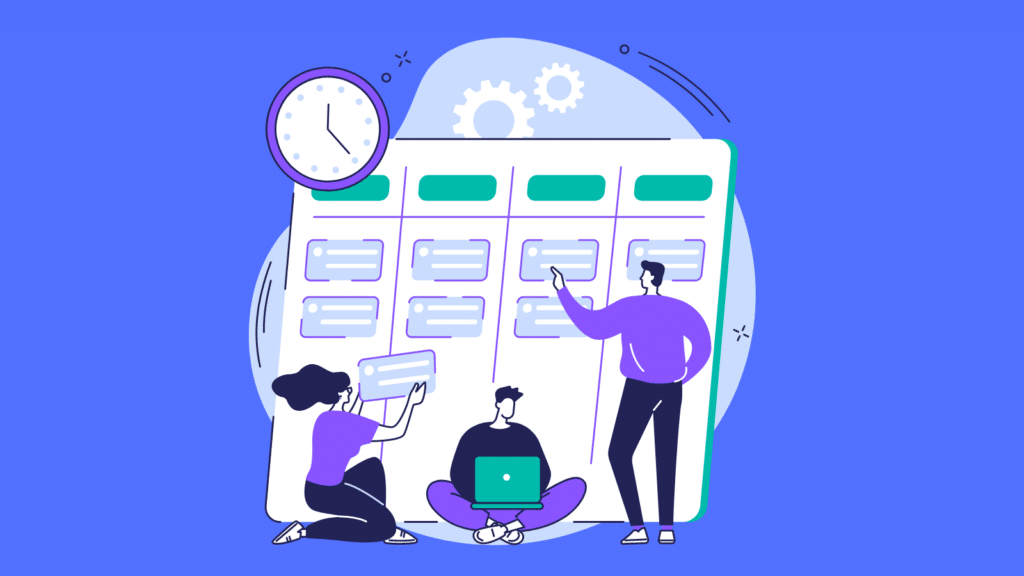
How time tracking helps to increase developers’ productivity
Time tracking is a method of recording and monitoring time allocation for different tasks and activities. It involves logging when work starts and ends, creating a detailed record of time spent throughout the day. Time tracking is essential for productivity analysis, optimizing time management, and making informed resource allocation and project progress decisions.
Time tracking improves developers’ productivity in several ways:
- Resource allocation: time tracking helps allocate resources effectively. Project managers can distribute tasks based on team members’ availability and skills, optimizing project workflows.
- Identifying code bottlenecks: time tracking helps pinpoint which parts of a project are consuming excessive time.
- Effective task estimation: With historical time tracking data, developers can better estimate how long specific coding tasks or projects will take.
- Project accountability: When developers track their time on different projects, it provides a transparent record of their contributions. This accountability can lead to improved teamwork and project management and help in justifying time allocation and resource allocation decisions.
- Documentation and reporting: developers can demonstrate their contributions and provide insights into project timelines when reporting to stakeholders.
Timeular: the best productivity tracker tool for developers
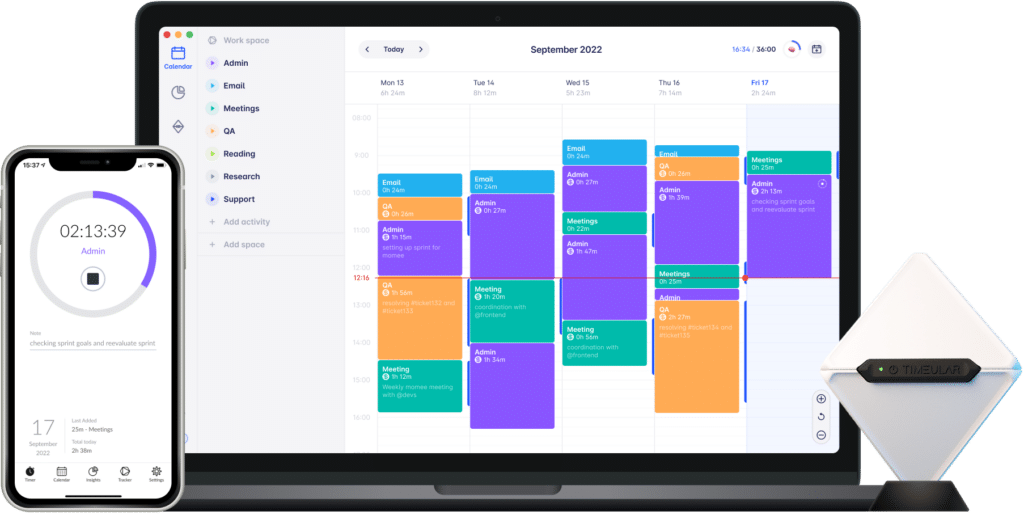
If there’s one tool that can significantly increase and help you measure developer productivity is Timeular.
Timeular is the most effortless productivity tracker software designed to help developers and teams handle their work time more efficiently.
+10,000+ companies such as Google, Audi, Toyota, McKinsey, Bang&Olufsen are already using Timeular to track their time and increase their productivity.
The top 5 features tailored to developers needs include:
- Effortless and intuitive time-tracking interface
- Automatisk tidsregistrering
- En fysisk sporingsenhet for å skape en vane med tidsregistrering
- Quicktrack - følg tiden med hurtigtaster uten å åpne Timeular
- Fakturerbar og ikke-fakturerbar sporing
- Automated productivity reports
- Sporing av fravær
- Over 3,000 integrations
- API for custom integrations and automation
Hvordan et programvarehus sporer tid i forhold til estimater for å forbedre nøyaktigheten
Effortless and intuitive time tracking
Timeular makes time tracking effortless with its incredibly intuitive interface and multiple tracking methods.
In Timeular, developers can track time with multiple methods, finding the one that suits them the best while maintaining their focus intact.
- Flipping the Time tracking hardware – you can flip to start tracking up to 1,000 activities
- Enabling automated time tracking – do your task, and Timeular will record your work on the background
- Bruke hurtigtaster
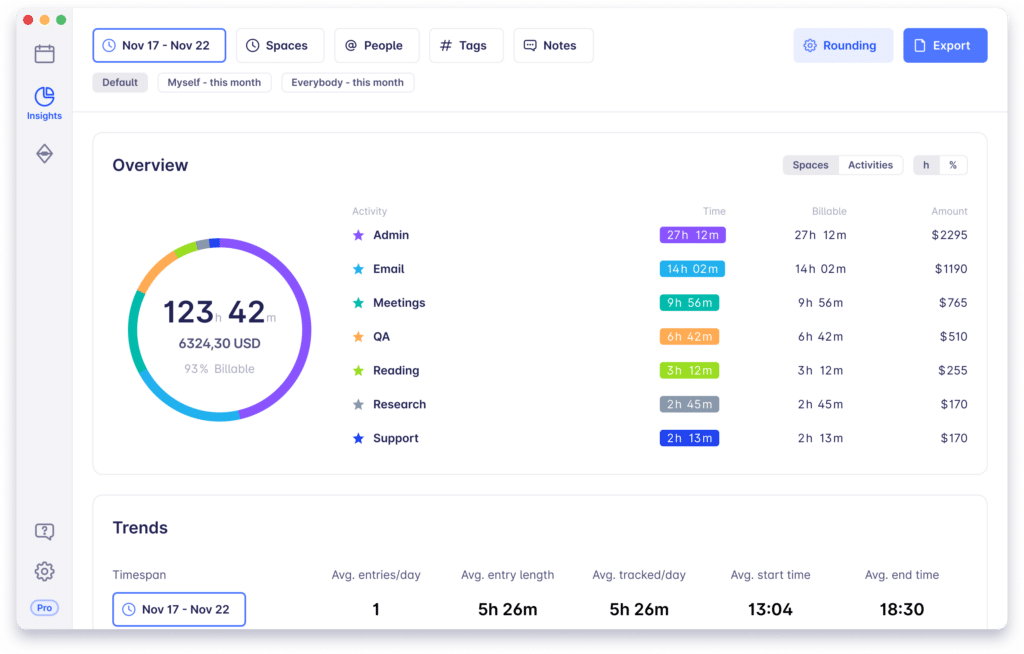
Automated insights
Timeular enhances client billing by automating tracking billable hours and creating transparent time reports for clients. Timeular aids in accurate billing and better project cost management by providing detailed reports on how time was spent on different aspects of a project, ensuring accurate invoicing and saving reporting time. Developers can build a precise breakdown of their activities to ensure that each little task is tracked and added to their invoices. Teams can export reports to PDF, XLSX, or CSV.
Cross-platform support
Developers can access Timeular on their desktop, smartphone, or tablet, ensuring that they can track time no matter where they are.
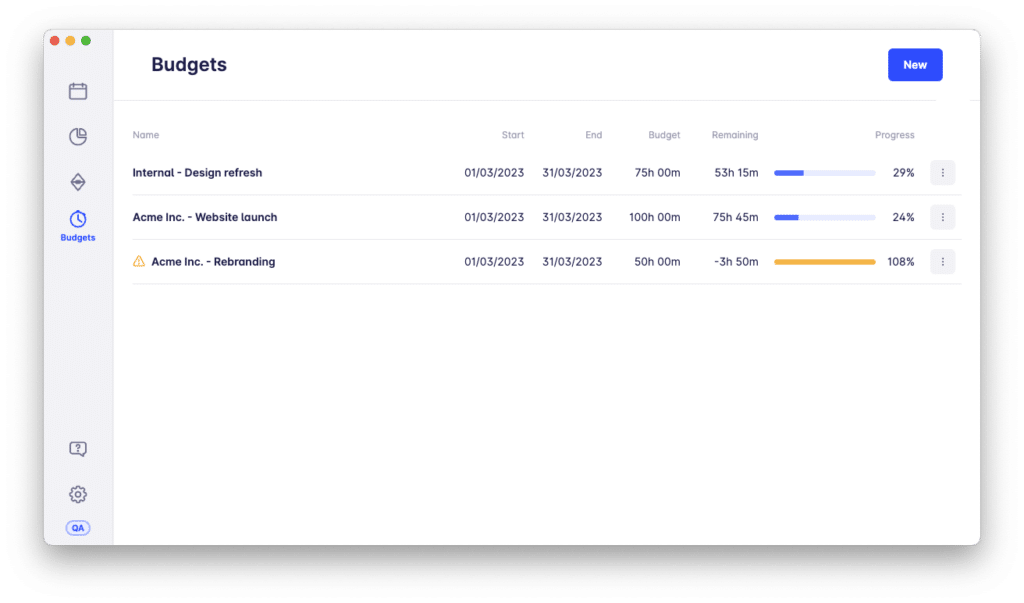
Det holder budsjettene under kontroll
In Timeular, developers can closely monitor project budgets to survey their progress and profitability. You can swiftly identify projects at risk of surpassing budgets and reallocate the team’s time to where it is most needed.
Tracking in Timeular has increased the amount of hours worked that are reported. Before some things were forgotten and missed off. Now the whole day is in Timeular and we have all of the information we need
Roman Haag, partner i iAgentur
Vurderinger
+Mer enn 10 000 selskaper som Google, Audi, Toyota, McKinsey, Bang&Olufsen og andre bruker allerede Timeular. Start din 30 dagers gratis prøveperiode i dag!
Konklusjon
Measuring developer productivity is essential for organizations striving to deliver high-quality software efficiently. The SPACE framework provides a comprehensive view of productivity, considering factors like satisfaction, communication, efficiency, and innovation.
To measure productivity effectively, use a combination of quantitative and qualitative metrics, define clear objectives, and implement time tracking tools like Timeular.
Choose a measurement approach that aligns with your organization’s values and goals, whether it focuses on individuals, teams, or both.
Remember that improving developer productivity isn’t just about metrics; it’s about creating a positive work environment, promoting collaboration, and prioritizing employee well-being!
Organizations can gain a competitive edge and deliver exceptional software products by measuring productivity thoughtfully and implementing strategies to enhance it.
Du er kanskje interessert i: